Hall Sapphire and Diamond Necklace
Open FREE Unlimited Store Join Our Newsletter
Dr. Larif M. Shihaan
Origin of Name
The Hall Sapphire and Diamond Necklace gets its name from the Late Mrs. Evelyn Annenberg Jaffe Hall, newspaper heiress, philanthropist and a connoisseur, collector and patron of the Arts, who following the example set by her elder sister Mrs. Janet Annenberg Hooker, who donated the US$500,000 worth Hooker Emerald Brooch to the National Museum of Natural History of the Smithsonian Institution in 1977, decided to follow suit and donated an equally impressive and exemplary piece of jewelry of her own in 1979, to enrich the collection of the National Museum. This piece of jewelry is the Hall Sapphire and Diamond Necklace designed by Harry Winston Inc. featuring 36 cushion-cut Sri Lanka blue sapphires, accented by pear-shaped and round brilliant-cut colorless diamonds. Evelyn (1911-2005) was the seventh of eight chidren - seven girls and a boy - born to Moses Annenberg and his wife Sadie, founder of the publishing empire, Cecilia Corporation that subsequently became the Triangle Publications, whose publications included The Morning Telegrah of New York, The Philadelphia Inquirer, the Daily Racing Form and the TV Guide magazine. Her sister Janet Annenberg Hooker was a renowned philanthropist and the principal benefactor of the NMNH of the Smithsonian Institution, donating US$5 million to the institution, that enabled them to construct their modern Hall of Geology, Gems & Minerals, named in honor of Mrs. Janet Annenberg Hooker. Following in the footsteps of her sister, Mrs. Evelyn Annenberg Jaffe Hall also became famous for her philanthropy, the chief beneficiaries being the Museum of Modern Art and the Memorial Sloan-Kettering Cancer Center.
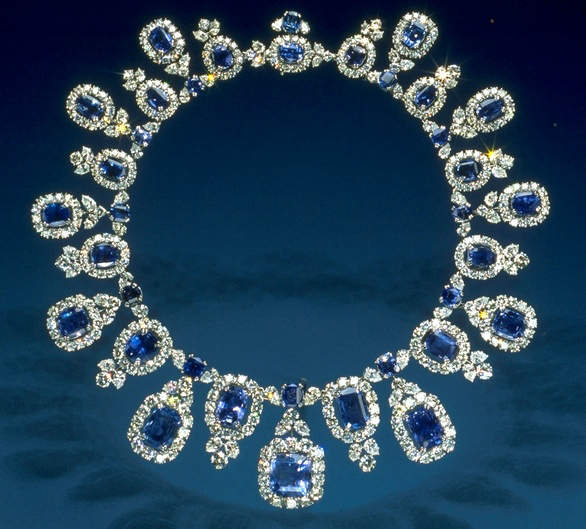
Hall Sapphire and Diamond Necklace
Photo - by Chip Clark
Characteristics of the Sapphire and Diamond Necklace
The Hall Sapphire and Diamond Necklace was designed by Harry Winston Inc. and bears the hallmarks of the renowned jewelry house such as exquisite design and craftsmanship, the use of well-matched sapphires and diamonds, set with perfect mathematical precision and symmetry, and the use of the highest quality sapphires and diamonds, with perfect cut, color and clarity. The necklace features 36 cushion-cut Ceylon/Sri Lanka blue sapphires, with a total weight of 195 carats, set in platinum. The medium sky-blue color of the Ceylon sapphires is accented by diamond surrounds, consisting of 435 pear-shaped and round brilliant-cut diamonds, totaling 83.75 carats.

Hall Sapphire and Diamond Necklace on display at Smithsonian's NMNH
11 small cushion-shaped blue sapphires and 13 medium-sized cushion-shaped blue sapphires are placed alternately in the necklace. The small cushion-shaped sapphires are of uniform size, but the medium- sized cushion-shaped blue sapphires gradually increase in size towards the front of the necklace. Two pear-shaped colorless diamonds are placed on either side of the small cushion-shaped blue sapphire. Each medium-sized cushion-shaped blue sapphire is highlighted by an oval-shaped diamond surround consisting of 14 colorless round brilliant-cut diamonds, the whole setting forming a fringe terminating in a triad of diamonds, with a terminal round brilliant-cut diamond and two pear-shaped diamonds on either side. There are 13 fringes of this type right round the necklace, centered round 13 medium-sized cushion-shaped blue sapphire. The fringe at the rear of the necklace is separated from the fringes on either side by a triad of diamonds, and terminates in a small cushion-shaped blue sapphire with two pear-shaped diamonds on either side.

Close-up of the Hall Sapphire and Diamond Necklace showing two types of fringes
Photo - by Chip Clark
11 other fringes arise from the small cushion-shaped sapphires, in which each fringe is attached to the cushion-shaped sapphire by a triad of colorless diamonds, and terminating in a medium-sized cushion-shaped blue sapphire, with a rectangular-shaped diamond surround, made of 14 colorless round brilliant-cut diamonds. In these fringes too the graduated blue sapphires increase in size from the rear of the necklace to the front, with the largest blue sapphire situated in the central fringe.
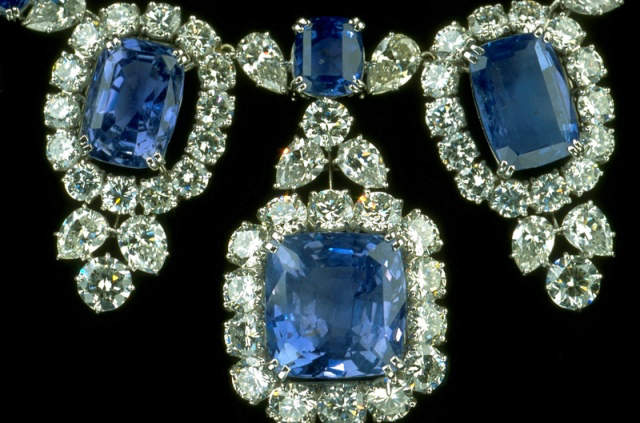
Close-up of Hall Sapphire and Diamond Necklace with fringes further enlarged
Photo - by Chip Clark
Hence, the Hall Sapphire Necklace, consists of two types of fringes alternating with one another - 11 larger fringes and 12 smaller fringes. The larger fringe begins with a triad of diamonds and terminates in a medium-sized cushion-shaped blue sapphire, highlighted by a rectangular-shaped diamond surround. The smaller fringes begins with a medium-sized blue sapphire highlighted by an oval-shaped diamond surround and terminates in a triad of diamonds. The rear fringe terminates in a sapphire and two pear-shaped diamonds.
Source of the Sapphires
The source of the sapphires incorporated in the Hall Sapphire and Diamond Necklace is Sri Lanka, formerly known as Ceylon, the most ancient source of Sapphires in the world, which according to Sir Emerson Tennent supplied the court of King Solomon of Israel, the son and successor of David, who sent his ships to the Island of Sri Lanka in the 10th century BC, to obtain supplies of precious and semi-precious stones, ivory, and also apes and peacocks, found abundantly on the island.
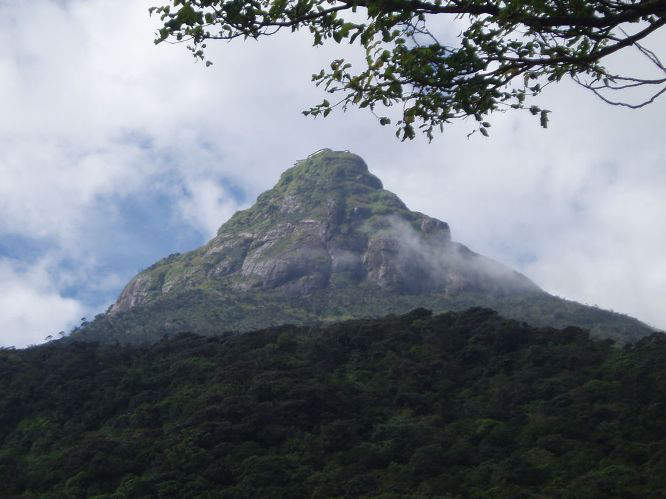
Adam's Peak and the surrounding wilderness

Adam's Peak Wilderness with the Peak in the background
In Sri Lanka, the most ancient source of blue sapphires, that also produced famous sapphires such as the “Logan Blue Sapphire”, the “Blue Giant of the Orient,” the "Queen Mary of Romania Sapphire," and the "Blue Belle of Asia," is undoubtedly the traditional and historic gem-mining district of Ratnapura (City of Gems), situated in the Sabaragamuwa (Saffaragam - Land of Sapphires) Province, of Sri Lanka, which was the main source of sapphires and rubies for over 2,500 years. Ratnapura district is also the area where one of the highest mountains known as the Adam's Peak, is situated. This peak is part of the central highlands of Sri Lanka, which occupies the south-central part of the country. The exposed gem-bearing igneous and metamorphic rocks of the central highlands were eroded by the action of heat, heavy rainfall, wind etc. over millions of years, and carried by the rivers and streams that originated from the central hills and flowing towards the low-lying areas eventually ending up in the seas. The eroded gem-bearing gravel was deposited in the flood plains of these rivers as alluvial deposits.
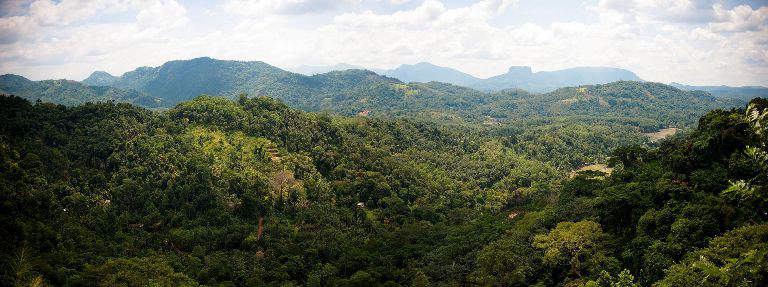
Adam's Peak Wilderness, World Heritage Site, with the Bible Rock in the background
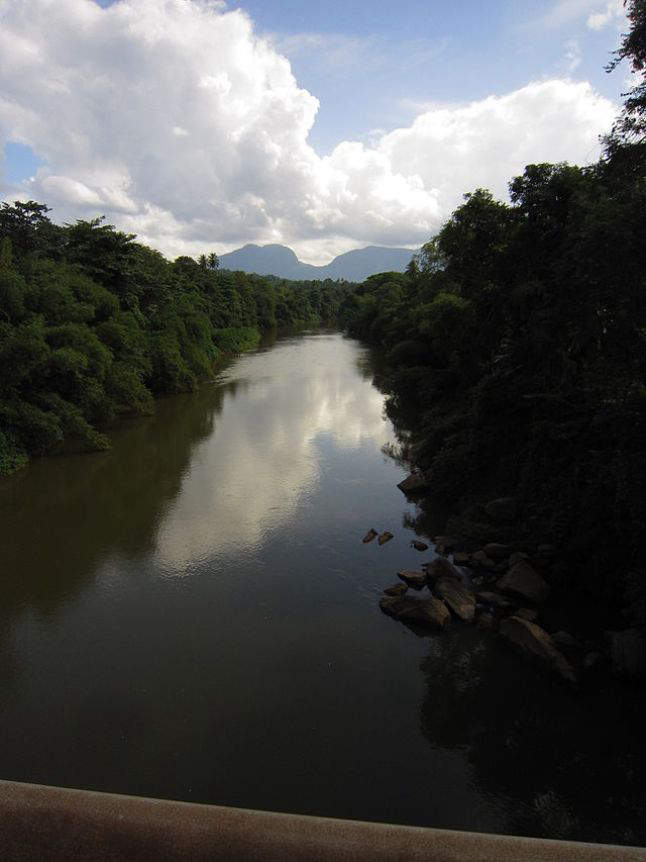
Kalu Ganga (Black River) flowing through Ratnapura
The major river that flows through the Ratnapura district is the “Kalu Ganga” (Black River) that originates in the Adam's Peak mountain range (World Heritage Site). The gem gravels that were washed down the hills were deposited in the flood plains of this river in the district, and became the source of the numerous rubies and sapphires discovered since ancient times. The blue sapphires of the "Hall Sapphire Necklace" in all probability also originated in this region.
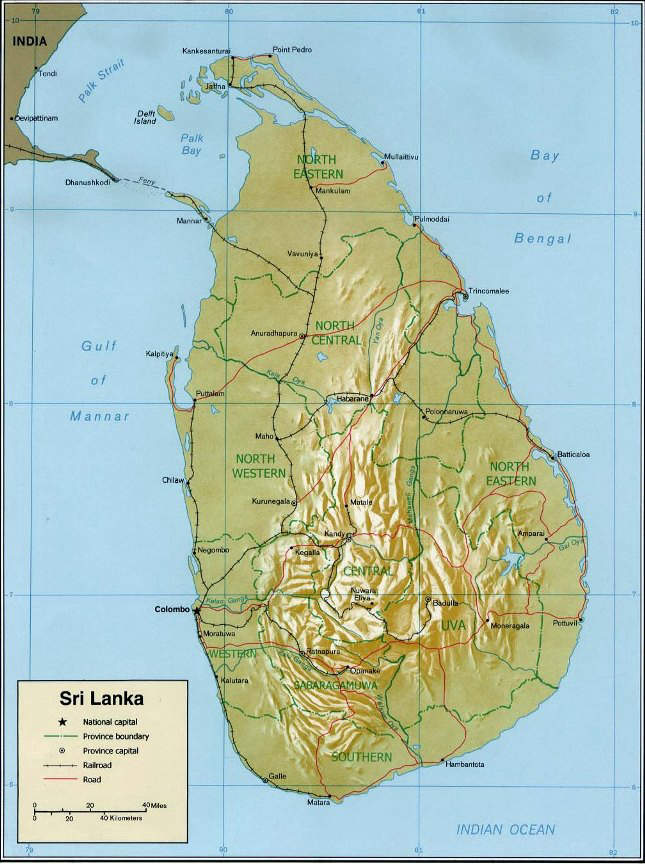
Sri Lanka relief map showing the south central hills

South Central region of Sri Lanka enlarged showing Sabaragamuwa Province, Ratnapura and the Kalu Ganga
Special feature of Sri Lanka blue sapphires
One of the distinguishing features of most of the blue sapphires originating in Sri Lanka is their low iron content, which is directly related to their color and their ability to fluoresce in ultra-violet light. The low iron content gives a lighter but brighter blue color to most of the Sri Lankan blue sapphires. While in an aesthetic sense the color may appear to be pleasing, the increase in translucency and clarity of the stones may be counterproductive as inclusions in the stone become more apparent. In the high iron content darker blue shades of sapphires whose clarity is low, the inclusions may not be quite apparent.
The low iron content in the Sri Lankan blue sapphires causes them to fluoresce in long wave length ultra-violet light giving a red or orange fluorescence. Sapphires originating from most other areas of the world are inert to ultra-violet light due to their high iron content. (Sri Lankan rubies too show a strong orange-red fluorescence in long wave length ultra-violet light caused by chromium in the absence of iron.) Thus the presence of fluorescence in a blue sapphire might indicate that the gemstone is of Sri Lankan origin.
Other characteristics of Sri Lanka blue sapphires
1) Sri Lankan blue sapphires can have every possible shade of blue, varying from delicate sky blue colors to rich saturated hues. However, they are generally lighter and brighter than the Kashmir and Burmese sapphires, and possess a saturated medium blue color that does not normally need enhancement by heating. Some areas of Sri Lanka (Rakwana and Elahera) also produce the famous corn-flower blue sapphires so characteristic of the famous and elusive Kashmir blue sapphires.These sapphires have the unique velvety blue color of the Kashmir sapphires.
2) The degree of transparency and clarity of Sri Lankan sapphires are excellent, and due to this the color of the stones appear to be spread homogeneously, even though closer microscopic examination shows distinct color zoning, with alternate colored and colorless bands as in Kashmir sapphires. One of the best examples of a Sri Lankan sapphire with a high degree of transparency and clarity is the 422.99-carat, rich deep blue, internally flawless, cushion-cut Logan Blue Sapphire , which is perhaps the second largest faceted blue sapphire in the world.
3) Rutile fibres known as silk are either evenly distributed, laid down in a hexagonal pattern alternating with colored zones, or laid down in patches forming cloud-like and other irregular patterns as in Kashmir sapphires.
4) Apart from rutile fibres other common solid inclusions found in Sri Lankan sapphires are zircon which form zircon halos or round-shaped or needle-lile crystals, rounded or dark prisms of rutile, hexagonal prisms of apatite, spinel octahedra, cube-shaped black uraninite crystals and needle-like or tabular crystals of diaspore.
5) Common liquid and gaseous inclusions include both liquid and gaseous carbon dioxide, forming feathers and fingerprints, which are healing patterns produced by the healing of fractures over a long period of time.
6) Negative crystals which are primary cavities formed during the rapid growth of the sapphire crystal and which may be filled partially or totally with liquid/gas (single-phase), or liquid/gas + solid (two-phase) or liquid + gas + solid (three-phase) inclusions, are quite common in Sri Lankan and Madagascar sapphires but less common in sapphires from other sources.
Sri Lanka is renowned for its extraordinarily large gemstone quality blue sapphires.
Sri Lanka is the only country in the world that had produced extraordinarily large gem-quality blue sapphires over the years, and most of the crown jewels of monarchies, and museum collections around the world, include large blue sapphires that originated in Sri Lanka. Thus, in the List of Blue Sapphires Greater than 100 Carats in Weight, the fact that 10 out of 17 sapphires listed are of proven Sri Lanka origin, is a little cause for surprise. Sapphires crystallize in the trigonal crystal system forming several crystal habits, of which the common habits are hexagonal bipyramidal, granular, massive and tabular, that can sometimes grow to enormous sizes. In fact, even the world's largest rough blue sapphire crystal, weighing 40.3 kg (88.66 lbs.or 201,500 carats) is of Sri Lankan origin, and is the proud possession of Mr. Jinadasa Guruge of Kahawatte, Sri Lanka. Kahawatte is also a town in the Ratnapura district. The giant sapphire still preserves its original hexagonal bipyramidal form, with four fully developed crystal faces on each side of the bipyramid, and indications of a fifth face on one side, and sharp crystal face junctions. The dimensions of the crystal are 47 x 29 x 28 cm. The circumference of the crystal is 85 cm. The color of this massive crystal is blue, greyish-blue and white.
According to gemologist Leslie J. Punchihewa who examined the massive crystal, a fair proportion of this specimen consists of light medium to deep medium blue gem-quality rough material. Portions of the specimen will also provide material suitable to turn out blue star sapphires and certain other parts would furnish "Geuda" material suitable for heat treatment. He further states, that going by past experience of similar quality rough material one cannot exclude the possibility of the presence of fine quality rough material at the core of this massive specimen.
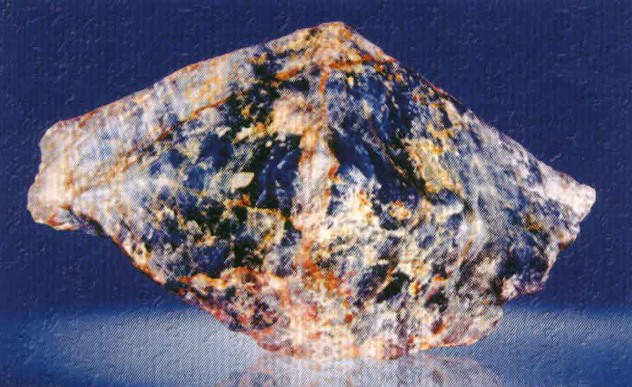
One view of the Jinadasa Guruge hexagonal bipyramidal 40.3 kg rough sapphire crystal
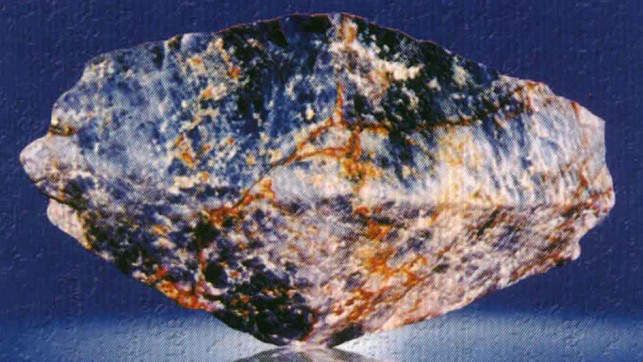
Another view of the Jinadasa Guruge hexagonal bipyramidal 40.3 kg rough sapphire crystal
Evelyn Annenberg Hall - A Short Biography
Mrs. Evelyn Annenberg Jaffe Hall, newspaper heiress, philanthropist and a connoisseur, collector and patron of the Arts, was the seventh of eight chidren - seven girls and a boy - born to Moses Annenberg and his wife Sadie, founder of the publishing empire, Cecilia Corporation that subsequently became the Triangle Publications, whose publications included The Morning Telegrah of New York, The Philadelphia Inquirer, the Daily Racing Form and the TV Guide magazine. Her only brother was Walter Annenberg, publisher, philanthropist and diplomat, who took over the family business, after his father's death in 1942 and built up a successful publishing empire known as the Triangle Publications, eventually branching into other mass media, such as radio and TV.
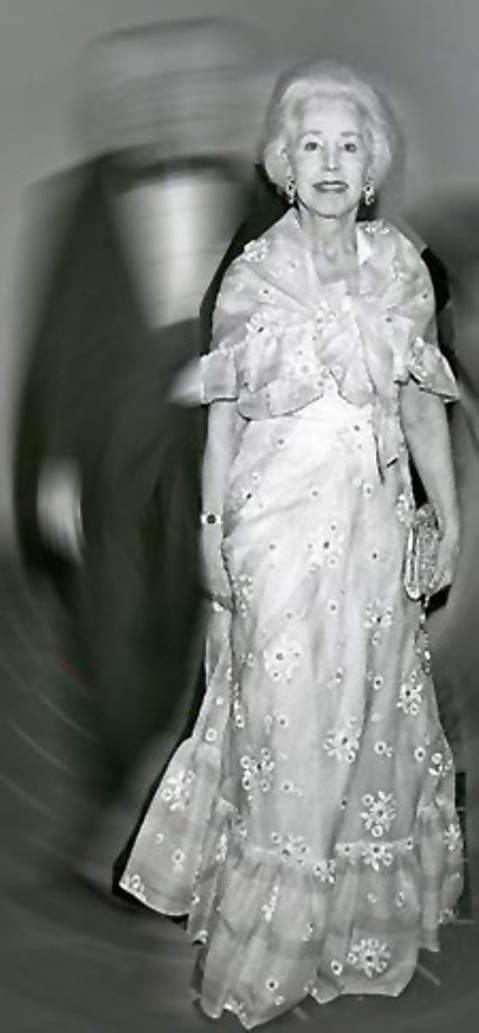
Evelyn Annenberg Jaffe Hall at a party in Palm Beach in 1980
Photo Courtesy - www.newyorksocialdiary.com
Born to a Jewish family in Milwaukee in 1911, Evelyn graduated from the Calhoun School and studied at the Art Students League of New York. She was married three times. Her first marriage was to Kenneth Friede, which ended in divorce. Her second marriage in 1947 was to corporate lawyer William B. Jaffe, who died in 1972. Her third husband was Melville Hall of Palm Beach, who died in 1991.
With her second husband, William Jaffe, she assembled an outstanding private art collection that included European paintings, sculpture and antique furniture, Chinese porcelain, pre-Colombian artifacts and Renaissance drawings. Her collection included work by renowned artists such as Pierre Bonnard, Pablo Picasso, Joan Miró, Édouard Vuillard, and Edvard Munch.
Mrs. Evelyn Hall shared her fortune with many beneficiaries, including the Museum of Modern Art and and the Memorial Sloan-Kettering Cancer Center, which were her favorites. Other beneficiaries include the Metropolitan Museum of Art, the Brooklyn Museum and Yale University where she sponsored a scholarship in art history. In 1960 she endowed the Jaffe-Friede Art Gallery at Dartmouth College. She was also a donor to Mount Sinai Hospital, where she endowed a lecture series at the medical school.
Mrs. Hall was a member of the Museum of Modern Art's International Council since 1970, and a trustee since 1979. As a leading member she took an active part in various museum committees and became a leading donor to the museum's collections. Among works from her private art collection given to the Museum of Modern Art were pieces by Pierre Bonnard, Pablo Picasso, Joan Miró and Édouard Vuillard. Another notable gift, made with her second husband Mr. William Jaffe, was a selection of 16 prints by Edvard Munch.
Apart from her home on the Upper East Side of Manhattan, she also had homes in Palm Beach, Fla., and Newport, R.I. Mrs. Evelyn Annenberg Jaffe Hall died on April 21, 2005 at the age of 93. She is survived by three sons, John Friede of Rye, N.Y.; Robert Friede of Newton, Mass.; and Thomas Jaffe of Manhattan; a sister, Enid Haupt of Greenwich, Conn.; three grandchildren; and four great-grandchildren.
You are welcome to discuss this post/related topics with Dr Shihaan and other experts from around the world in our FORUMS (forums.internetstones.com)
Related :-
9) Hooker Starburst-Cut Yellow Diamond Jewelry Suite
External Links :-
https://geogallery.si.edu/index.php/en/1005282/hall-sapphire-necklace
https://mineralsciences.si.edu/collections/gem_gallery/
https://commons.wikimedia.org/wiki/File:Hall_Sapphire_
https://www.newyorksocialdiary.com/social-history/2008/best-friends-jewish-society-in-old-palm-beach
References :-
1) Gem Gallery - Hall Sapphire Necklace - https://geogallery.si.edu/index.php/en/1005282/hall-sapphire-necklace
2) Gem Gallery - Hall Sapphire Necklace - https://mineralsciences.si.edu/collections/gem_gallery/
c/hallSapphire.htm
3) Hall Sapphire and Diamond Necklace - https://commons.wikimedia.org/wiki/File:Hall_Sapphire
_and_Diamond_Necklace.jpg
4) Evelyn Annenberg Hall, 93, Arts Patron, Dies - The New York Times - Obituaries. https://www.nytimes.com/2005/04/29/obituaries/
29hall.html?fta=y&_r=1&
5) Walter Annenberg - From Wikipedia, the free encyclopedia
6) Gem Trade Laboratory - The Giant Corundum Crystal of 40.3 Kg. https://mtzconsulting.weebly.com/uploads/1/1/5/3/
11535536/gemstone_brochure_-_composite.pdf
7) Best Friends: Jewish Society in Old Palm Beach - https://www.newyorksocialdiary.com/social-history/2008/best-friends-jewish-society-in-old-palm-beach
Powered by Ultra Secure
Amazon (USA) Cloud Network

Founder Internet Stones.COM
Register in our Forums
| Featured In
|
|
|
|
|
|
|
|


















